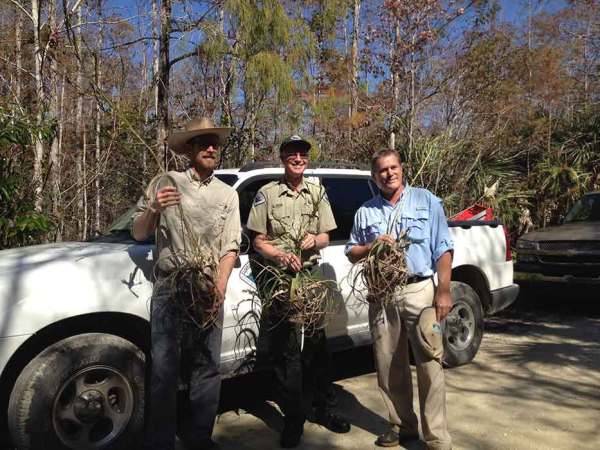by Mike Owen and Karen Relish
The Friends of Fakahatchee are an important part of a team to rescue bromeliads, especially the Tillandsia utriculata or Giant Air Plants, seemingly a favorite of the non-native Metamasius callizona or Mexican Bromeliad Weevil. Typically, after about 10 to 15 years of growth, the Giant Air Plant sends up a seed stalk or spike up to 6 feet long, produces flowers in June, then produces thousands of seeds during spring, and then dies unlike many of the other Florida bromeliads which can also reproduce vegetatively by pupping.

Chad Washurn of Naples Botanical Garden, Fakahatchee biologist Mike Owen, and Bruce Holst of Selby Botanical Garden with the Giant Air Plants.
The Friends of Fakahatchee contributions will assist other team members at Naples Botanical Gardens, Selby Botanical Gardens and possible affiliates to educate, quarantine/monitor, then regularly treat with an insecticide the recovered plants as well as provide materials to re-attach to hosts, and logistical support for the Giant Air Plants from Fakahatchee Strand Preserve State Park and from its headwaters Okaloacoochee Slough State Wildlife Management Area and other Florida Natural Areas.
Work on the Giant Air Plant and other bromeliads at Fakahatchee and other parks around the state was initiated at University of Florida by Teresa Cooper for her graduate work. She is currently working for Indian River Research and Education Center in Fort Pierce with Ron Cave. From December 2008 through December 2013, Mike Owen and primarily two Fakahatchee volunteers continued and expanded the monitoring within the center of the Fakahatchee Strand along 7 miles of Janes Scenic Drive. With the dedicated efforts of the two volunteers, including one who entered the data and created the graphs, the monitoring efforts produced an annual snapshot of the Mexican bromeliad weevil invasion that reached the sampling area in 2010. The December 2013 data revealed an over-80% decline of the Giant Air Plants, especially north to south along Janes Scenic Drive. Upon seeing this in graph form, Mike Owen obtained the necessary permission and permits to collect some of the known remaining surveyed plants, approximately 160 of them, to place under the conservation efforts of the Gardens’ staff and volunteers to enable a healthy seed stalk and seed production.
On November 13, 2014, 16 Giant Air Plants were ready to be returned to the Fakahatchee. Using the data gathered, they were returned to as close to the same tree, height, and distance from Janes Scenic Drive that they originated. Team members from both Gardens, including interns from Belize, and Fakahatchee staff and volunteers assisted in this process. By the time these seeds mature into plants, we are hoping with the tireless team efforts that we will see them produce healthy seed stalks and successfully release thousands of seeds back to the Fakahatchee Strand. Each year in November the plants, safely protected from the ravages of the weevil larvae at the two Botanical Gardens, that produced a spike during the previous June will be returned to the Fakahatchee Strand to continue the release of seeds into the swamp.
